
Parrotfish are a group of fish species traditionally regarded as a family (Scaridae), but now often treated as a subfamily (Scarinae) or tribe (Scarini) of the wrasses (Labridae). With roughly 95 species, this group's largest species richness is in the Indo-Pacific. They are found in coral reefs, rocky coasts, and seagrass beds, and can play a significant role in bioerosion.
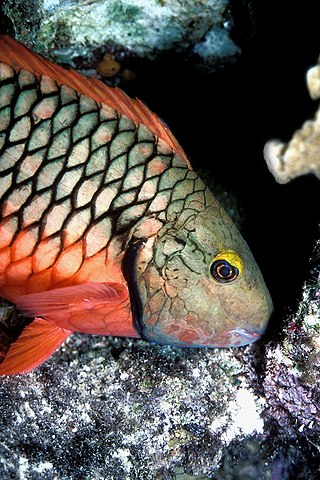
Sparisoma is a genus of parrotfishes native to warmer parts of the Atlantic. FishBase recognizes 15 species in this genus, including S. rocha described from Trindade Island in 2010 and S. choati described from the East Atlantic in 2012. They are the most important grazers of algae in the Caribbean Sea, especially since sea urchins, especially Diadema, the other prominent consumers of algae, have been reduced in many places by a recent epidemic.
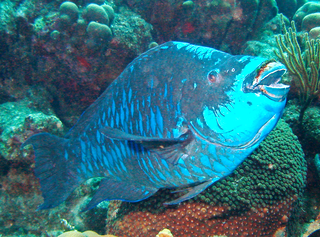
The midnight parrotfish is a species of parrotfish that inhabits coral reefs mainly in the Caribbean, Bahamas, and Florida.

The princess parrotfish is a species of marine ray-finned fish, a parrotfish, in the family Scaridae. It is typically 20 to 25 centimetres long, found in the Caribbean, South Florida, the Bahamas, and Bermuda. Its behavior, similar to other parrotfishes, is to swim about the reef and sandy patches during the day, at depths between 3 and 25 metres, scraping algae on which it feeds.

Cetoscarus bicolor, also known as the bicolour parrotfish or bumphead parrotfish, is a species of fish belonging to the family Scaridae. It is found only in the Red Sea.
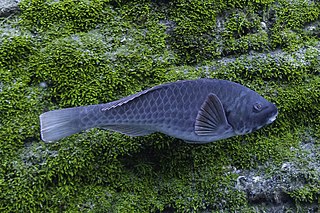
The Mediterranean parrotfish is a species of parrotfish found at depths up to 50 m (160 ft) along rocky shores in the Mediterranean and the eastern Atlantic, from Portugal south to Senegal. It is generally common, but uncommon or rare in the northwestern Mediterranean and in the Adriatic Sea. It prefers relatively warm temperatures and there is an ongoing northward range expansion, possibly due to global warming. The primary adult habitat is rocky reefs, especially in areas with macroalgae, but they may visit adjacent seagrass patches. Juveniles also occur more widely in the latter habitat.

The queen parrotfish is a species of marine ray-finned fish, a parrotfish, in the family Scaridae. It is found on reefs in the tropical West Atlantic Ocean and the Caribbean Sea. Other common names include blownose, blue chub, blue parrotfish, blueman, joblin crow parrot, moontail, okra peji and slimy head. The young males and adult female queen parrotfish are a reddish-brown color, and quite different in appearance from the bluish-green color of the final phase male. This is a common species throughout its range and the International Union for Conservation of Nature has rated its conservation status as "least concern".

The blue parrotfish is a member of the parrotfish genus Scarus. It is found on coral reefs in shallow water in the tropical and subtropical parts of the western Atlantic Ocean and the Caribbean Sea. They usually forage in a group of 500 individuals for spawning and deterring predators while feeding.
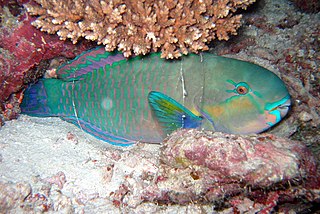
Chlorurus sordidus, known commonly as the daisy parrotfish or bullethead parrotfish, is a species of marine fish in the family Scaridae.

Sparisoma aurofrenatum is a species of parrotfish native to the Caribbean Sea and Western Atlantic Ocean.
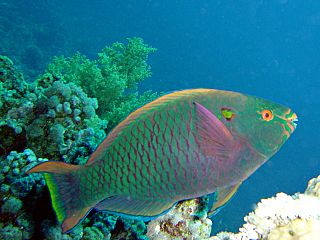
Scarus niger, common names the swarthy parrotfish, dusky parrotfish, and black parrotfish, is a species of parrotfish. It is in the phylum Chordata, class Actinopterygii, and family Scaridae. Like other members of its family, it has characteristic 10 dorsal soft rays, 9 dorsal spines, 9 anal soft rays, and 3 anal spines, It is found in Indo-West and Central Pacific, from the Red Sea, north to Japan, south to Australia and east to French Polynesia. It is found in lagoons, channels and outer reefs slopes on the depths of 2 to 20 metres. The dusky parrotfish often lives in solitude, but males may also live in a small group of mating females. The dusky parrotfish is primarily herbivorous, and its main source of food is benthic algae. At maturity, the fish is approximately 230-240mm long and weighs around 240g.

Hipposcarus harid, the Longnose parrotfish or Candelamoa parrotfish, is a species of marine ray-finned fish, a parrotfish from the family Scaridae found on coral reefs of Indian Ocean and the Red Sea.
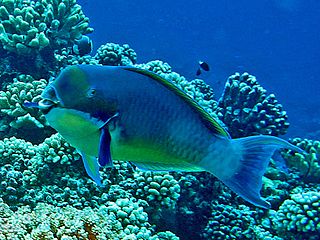
Chlorurus microrhinos, the blunt-head parrotfish or steephead parrotfish, is a species of marine ray-finned fish, a parrotfish from the family Scaridae. It is found in the Indo-Pacific region.

Calotomus carolinus, commonly known as Carolines parrotfish, is a species of marine ray-finned fish, a parrotfish, in the family Scaridae. It is also known as the starry-eye parrotfish, stareye parrotfish, bucktooth parrotfish, Christmas parrotfish or marbled parrotfish. Since the Calotomus carolinus is known across the Pacific, it also has its own name in many native languages for example, it is called a panuhunuhunu in the Hawaiian language.

Chlorurus capistratoides, commonly known as the Indian parrotfish or the pink-margined parrotfish, is a marine ray-finned fish, a parrotfish from the family Scaridae. This species is native to the eastern Indian Ocean and western Pacific Ocean, where it lives in coral reefs. This species occurs in small schools, frequently mixed in with other fish species, these schools forage over corals in clear coastal and inner reefs where there is abundant algal and coral growth. It feeds on filamentous algae.

A corallivore is an animal that feeds on coral. Corallivores are an important group of reef organism because they can influence coral abundance, distribution, and community structure. Corallivores feed on coral using a variety of unique adaptations and strategies. Known corallivores include certain mollusks, annelids, fish, crustaceans, flatworms and echinoderms. The first recorded evidence of corallivory was presented by Charles Darwin in 1842 during his voyage on HMS Beagle in which he found coral in the stomach of two Scarus parrotfish.

Chlorurus spilurus, known commonly as the Pacific daisy parrotfish or Pacific bullethead parrotfish and in Hawaiian called uhu, is a species of marine fish in the family Scaridae. The Pacific daisy parrotfish is widespread throughout the tropical waters of the Pacific.

Scarus fuscopurpureus, common name purple-brown parrotfish, is a species of marine ray-finned fish, belonging to the class Actinopterygii. It is a parrotfish in the family Scaridae. It occurs in the western Indian Ocean, the Red Sea, the gulf of Aden and the Persain Gulf. Countries in which boarder these waters include, but are not limited to Egypt, Sudan, Saudi Arabia, Yemen, Kuwait, and the United Arab Emirates.

Sparisoma choati, the West-African parrotfish, is a species of marine ray-finned fish from the family Scaridae. It occurs at depths between 2 and 30m, along west African coastline and islands from Cape Verde and Senegal south to the offshore islands of the Gulf of Guinea and northern Angola. Like other parrotfish of the genus Sparisoma, it lives on rocky reefs and grazes on algae growing over hard substrate. It was named in honor of J. Howard Choat, in recognition of his extensive scientific work on parrotfishes.

Scarus zelindae is a species of fish of the Scaridae family in the order Perciformes. This species of Parrotfish can be brown, blue, green, yellow, and purple and can change their colors several times throughout their lifetime. They live for about 5–7 years and can be found in the southwestern Atlantic Ocean, primarily in Brazilian waters.






















